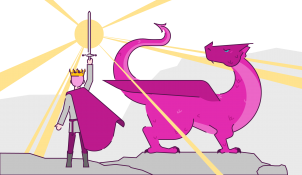Before we look at what a sales presentation opening should contain, and how it ought to be structured, we first need to ask what the introduction is actually for:
- To make the audience receptive to the key messages of the presentation. When the presenter looks at “why change?” or “why us?” the audience needs to be interested, and open the line of reasoning employed
- To make sure the audience feel that the presenter understand’s the audience’s situation (or similar situations)
- If necessary (and it isn’t always), to introduce the presenters or companies represented in the room to those who don’t already know who they are. This is most often necessary in formal settings, or with large groups, or when new people become involved – and particularly when you are from a small or ‘misunderstood’ company.
The amount of attention an audience will pay during and after a sales presentation opening is directly related to the quality of that introduction.
If the first six slides are about your office locations, turnover, and biggest clients – expect audiences to disengage.
If the first slides show that you understand the challenges your prospect faces, why they haven’t solved them yet, and the full implications of these challenges- expect an audience to pay attention.
In The Challenger Sale Dixon and Adamson reveal extensive quantitative research, finding that 53% of customer loyalty for B2B companies comes as a result of the purchase experience – including the advice and education that the sales person offers (p.47 Fig. 4.1). They also point out that so-called ‘Challenger’ reps (27% of their sample of 6000) dramatically outperform their peers (Fig 2.2) .These are reps who have (or present) a different view of the world, understand the prospect’s business, love to debate, and who push the customer. In other words, they don’t just tell the prospect what they want to hear, or talk about their own solution without reference to the prospect’s challenges.
Challenger Reps try to teach the prospect how to do things, and how to see things. According to Dixon and Adamson, challenger reps ought to deliver a teaching pitch:
‘A teaching pitch makes customers feel sort of sick about all the money they’re wasting, or revenue they’re missing, or risk they’re unknowingly exposed to.’ (p.67)
Not every part of every pitch should be teaching – but a sales presentation opening is a great place to try to teach prospects how to see the world. This is what the introduction of a “why change?” presentation should look like.
Sales presentation opening structure
Challenges
The first slides should state the problems that the customer has, or key issues they face; if benchmarking data or industry statistics are available, so much the better. The aim is to demonstrate that you know of other companies with challenges that the prospect will recognise. Don’t use a 20-questions technique to establish what you already know; instead, set out the challenges that you think the prospect will be facing, and ask which are most relevant to them.
To avoid any sense of blame and the ensuing defensiveness that would provoke, explain the fact that the challenges aren’t solved to some change in the industry or environment. “It used to be easy, but Government changed the regulations.” “Before the Internet, this was easy to manage, but now things have exploded out of control”.
Key Insight
Then provide a new way of looking at the problem that explains why current attempts to address the problem haven’t worked. If you are selling equipment for taking blood, you might point out that a certain high proportion of laboratory test result quality is actually dependent on how blood is taken and transported to the laboratory, not just on the quality of what happens in the laboratory. If you are selling professional presentations (like BrightCarbon), you might point out that making bullet points look beautiful doesn’t help the communication be any more effective as people can’t read and listen to a presenter at the same time.
Implications
Next, expand on the key insight, to explain how failure to solve the problem has a cost, in terms of morale, productivity, lost revenue or so on. This essentially expands upon challenges section and asks “Why does this matter?”
Story
This next part isn’t always possible as the content isn’t always available, but when it is, it can work well. Tell a story about a customer that had the same problem, how the problem caused them pain, how change wasn’t necessarily easy, but how it was worth it. This allows the prospect to see themselves in the problem, and helps to break down their rational resistance to change by targeting an emotional response.
Shape of the Solution
Once you have persuaded the prospect that they have a problem you need to agree what capabilities the solution needs to have. This isn’t about pushing your solution – yet – but about framing the problem favourably. Does the buyer need to look for a solution that’s flexible, or scalable, or compliant with a certain new regulation, or delivered in a certain way?
The shape of the solution you argue for ought to subtly point the prospect to what you are offering. This section is a great way of alluding to competitor’s weaknesses, and persuading buyers that they really ought to find somebody without that weakness. You might not be the only provider that can deliver the right ‘shaped’ solution, but you should at least manage to exclude some competitors. You might not mention your own solution until the next meeting – see this section as laying the foundations for a successful sale.
For a presentation built around “why us?” the introduction might be somewhat different to the outline above. Whether it is or not depends to some extent on whether you are offering the buyer what they are asking for, or trying to shape their thinking so that they choose something a bit different from what they are planning to buy.
So, for example, if they have asked for a security guarding service that is flexible, highly-vetted, and with women guards – and you offer those things better than anyone else, your introduction won’t need to offer a key insight. Just show that you recognise the challenges they have, feedback and validate the shape of the solution that they shared with you, and then proceed to sell your solution. If you – to continue the example – don’t have any female security guards but want to persuade the buyer to want your male guards instead, then you also need to offer a key insight, explore the implications of failing to get the solution working by using female guards, and justify your attempt to offer something different.
Leave a comment




helpful information, thank you very much
my g’s this is good